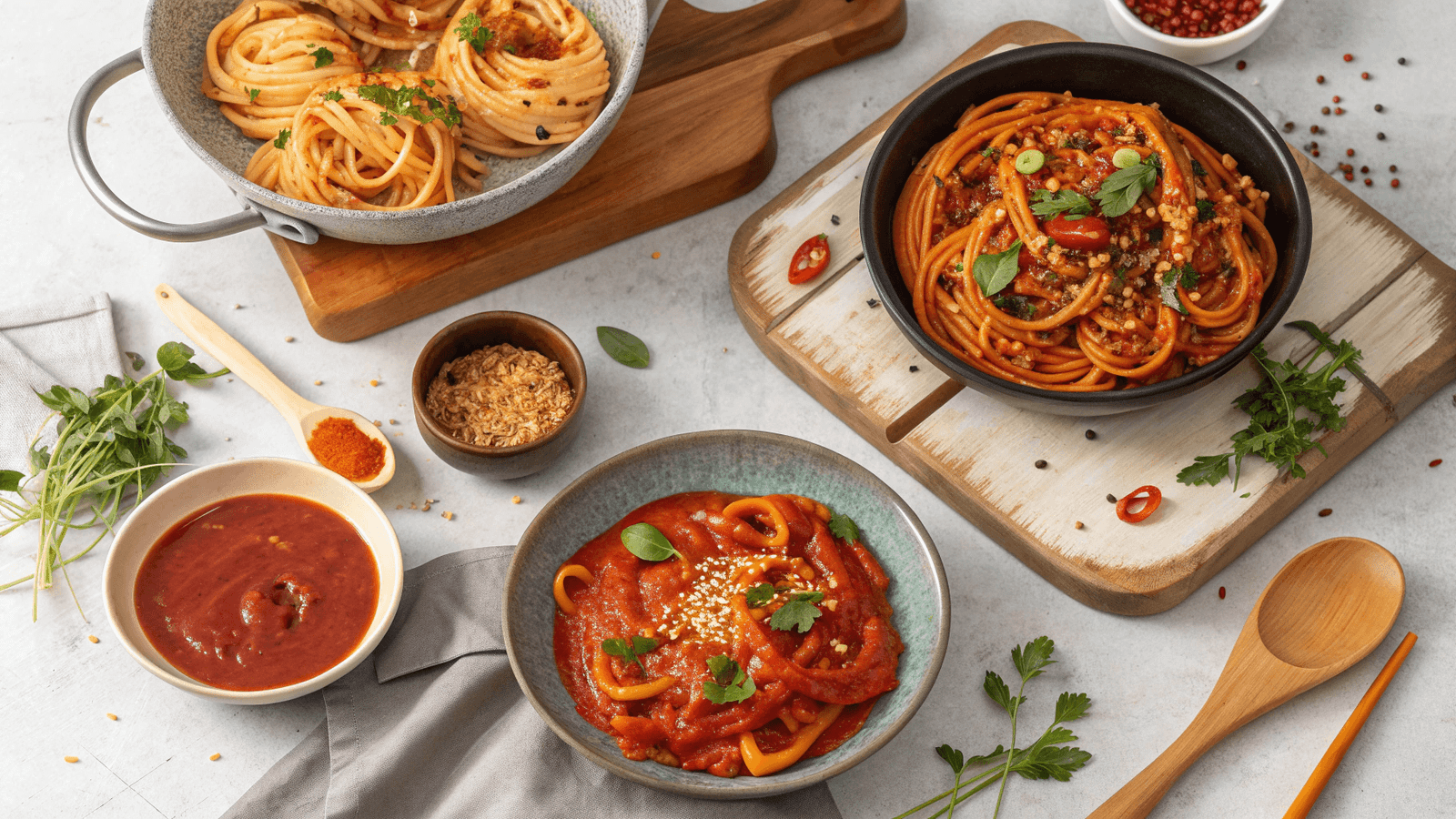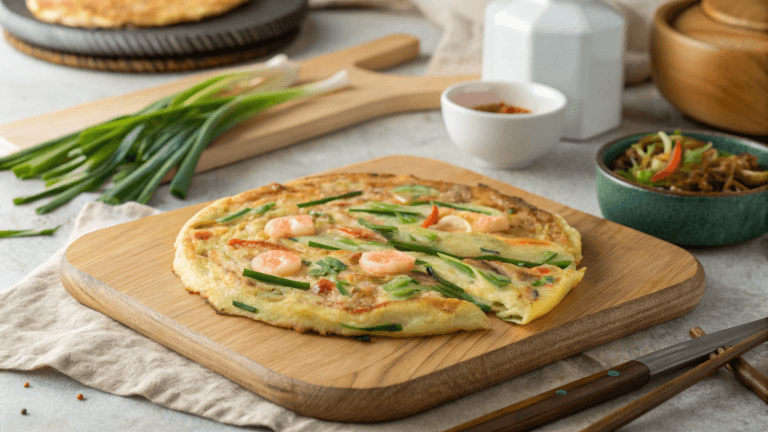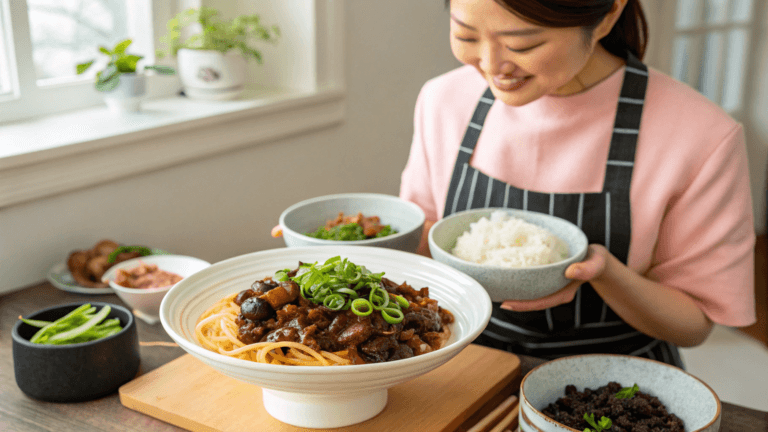5 Irresistible Gochujang Pasta Recipes for a Spicy, Savory Twist
Discover 5 irresistible gochujang pasta recipes for a spicy, savory twist! Perfect for weeknight meals or entertaining.
Table of Contents
I. Introduction: Embracing the Gochujang Pasta Craze
The culinary world is constantly evolving, embracing new flavors and fusions that tantalize our taste buds. Therefore, one ingredient has been making waves lately, not just in Korean cuisine, but across the globe: gochujang. This fermented Korean chili paste, with its complex blend of spicy, savory, and slightly sweet notes, is transforming how we experience food. However, gochujang isn’t just a trend; its unique character is now being beautifully woven into a variety of dishes, and perhaps the most exciting is gochujang pasta. It’s no wonder that gochujang pasta is trending as it is a very tasty and versatile ingredient!
Gochujang is a pantry staple for its depth of flavor. Indeed, it’s a vibrant red paste made primarily from Korean red chili powder (gochugaru), glutinous rice, fermented soybeans, and salt. The fermentation process is key, imbuing the paste with umami richness and a subtle tang. Because it is such a good addition for so many meals, people are keen to try it.
But why pair it with pasta? Simple – the versatility of pasta lends itself perfectly to gochujang’s robust flavor profile. Furthermore, pasta is a blank canvas, ready to absorb the flavors of the sauce. Whether you are making a quick weeknight meal or entertaining guests, pasta is a perfect vehicle to showcase the distinctive and exciting flavors of gochujang. From simple spaghetti dishes to more elaborate creations, gochujang brings a unique spicy-savory element to any pasta shape.
This article is designed to be your guide to creating unforgettable gochujang pasta dishes. We will explore five distinct recipes, each designed to showcase the versatility and deliciousness of this remarkable ingredient. In addition, these recipes cater to various skill levels and preferences, ensuring there’s a perfect gochujang pasta experience for everyone. Finally, get ready to embark on a flavor journey as we explore the exciting world of gochujang pasta!
II. Understanding Gochujang: The Heart of the Flavorful Pasta
Gochujang isn’t just a spicy condiment; it’s a cultural touchstone. In addition, its history is deeply intertwined with Korean culinary traditions. So, to better understand the taste of gochujang, we’ll break down all the nuances.
A. History and Origin of the Delicious Gochujang
Gochujang’s origins can be traced back to the Joseon Dynasty in the 18th century, when chili peppers were introduced to Korea. The earliest forms of gochujang were less spicy and more fermented soybean-based. However, over time, chili peppers became the dominant ingredient, defining the spicy character we know today. Traditionally, gochujang was made at home, a cherished family ritual passed down through generations, often associated with the arrival of spring. Thus, for many Koreans, this has a lot of meaning and history.
B. Ingredients and Production
The production of gochujang is a careful process. The primary ingredients include gochugaru (Korean chili powder), glutinous rice flour (or sometimes barley flour), meju (fermented soybean powder), salt, and sometimes sweeteners like corn syrup or brown rice syrup. The glutinous rice is cooked and mixed with the meju, gochugaru, and salt to create a thick paste. This mixture is then left to ferment in earthenware crocks, often outdoors, where the sun and air contribute to the flavor development. Finally, the fermentation process, lasting from months to years, allows the flavors to meld, creating the complex and nuanced taste that defines gochujang.
C. Flavor Profile Deep Dive
The flavor profile of gochujang is what makes it so captivating. It delivers a punch of heat, but the spiciness is balanced by savory, umami, and subtly sweet notes. The heat level can vary depending on the gochugaru used; it can range from mild to very hot. Umami, the savory taste, comes from the fermentation of the soybeans and creates a depth of flavor that makes it incredibly addictive. The slight sweetness, derived from the rice and sometimes added sweeteners, rounds out the flavor, creating a harmonious balance. For this reason, it is loved all over the world.
D. Gochujang Quality and Types
When choosing gochujang, consider the quality and type. Look for gochujang that has a vibrant red color and a slightly thick texture. The label should list the ingredients clearly; avoid products with excessive additives or preservatives. The fermentation time affects the flavor; aged gochujang offers a more complex, developed taste. In addition, you can find mild, medium, and hot versions. Therefore, experiment to find what suits your preference.
E. Storage and Shelf Life
Proper storage is crucial to preserving the quality of gochujang. Once opened, store it in an airtight container in the refrigerator. This helps prevent mold growth and maintains its flavor and texture. Because of this, properly stored gochujang can last for several months, sometimes even a year or more, in the refrigerator. So, that’s a great advantage, as you can have it for a while.
III. Essential Ingredients and Tools for Creating Gochujang Pasta
Creating delicious gochujang pasta starts with having the right ingredients and tools. Therefore, let’s break down the essentials.
A. Pasta Selection
First, the pasta itself. Different shapes pair with sauces in different ways. For gochujang-based sauces, shapes that capture and hold sauce are ideal. Spaghetti, the classic choice, works well, but consider other options. However, fettuccine, with its wider surface area, is excellent for coating with a rich sauce. Penne and rigatoni, with their ridges and tubes, trap sauce inside, delivering a burst of flavor with each bite. In addition, bucatini, a thick spaghetti with a hole in the center, also grabs and holds sauce beautifully. Moreover, fusilli, with its spiral shape, is another excellent choice. Therefore, experiment with different shapes to find your favorite combination.
B. Protein Options for Flavorful Gochujang Pasta
Next, consider the protein. Chicken, shrimp, and plant-based alternatives offer excellent flavor combinations. Chicken thighs are tender and flavorful, perfect for cutting into bite-sized pieces. Shrimp cooks quickly and pairs beautifully with gochujang’s spice. If you prefer vegetarian options, tofu or tempeh offer a great alternative. Mushrooms are also an excellent choice. Thus, you have many options available to you.
C. Vegetables to Add to Your Pasta
Vegetables add color, texture, and nutritional value to your dish. For instance, onions and garlic are essential aromatics, laying a flavorful foundation. Bell peppers provide a touch of sweetness and crunch, while mushrooms offer an earthy depth. Broccoli florets or spinach add a healthy dose of greens. Furthermore, carrots can offer sweetness and texture. The options here are endless!
D. Aromatics and Flavor Enhancers
Aromatics and flavor enhancers bring depth to the sauce. Garlic and ginger are staples in Korean cuisine. Soy sauce or tamari adds umami and saltiness. Sesame oil and sesame seeds impart a nutty aroma and flavor. A touch of rice vinegar brightens the sauce, and honey or maple syrup can help balance the spiciness. Because of this, this is what brings it all together.
E. Essential Cooking Tools
Now for the tools. You’ll need a large pot for boiling the pasta, and a skillet or wok for cooking the sauce and other ingredients. A colander will drain the pasta. Measuring cups and spoons ensure accurate ingredient proportions. Mixing spoons or tongs are essential for tossing the pasta with the sauce. A chef’s knife and cutting board for preparing ingredients will also be needed. Without these basic tools, it will be impossible to create any dish.
IV. Recipe 1: Spicy Gochujang Shrimp Scampi Pasta
This recipe marries the classic flavors of shrimp scampi with the bold kick of gochujang. In addition, it’s quick, easy, and utterly delicious.
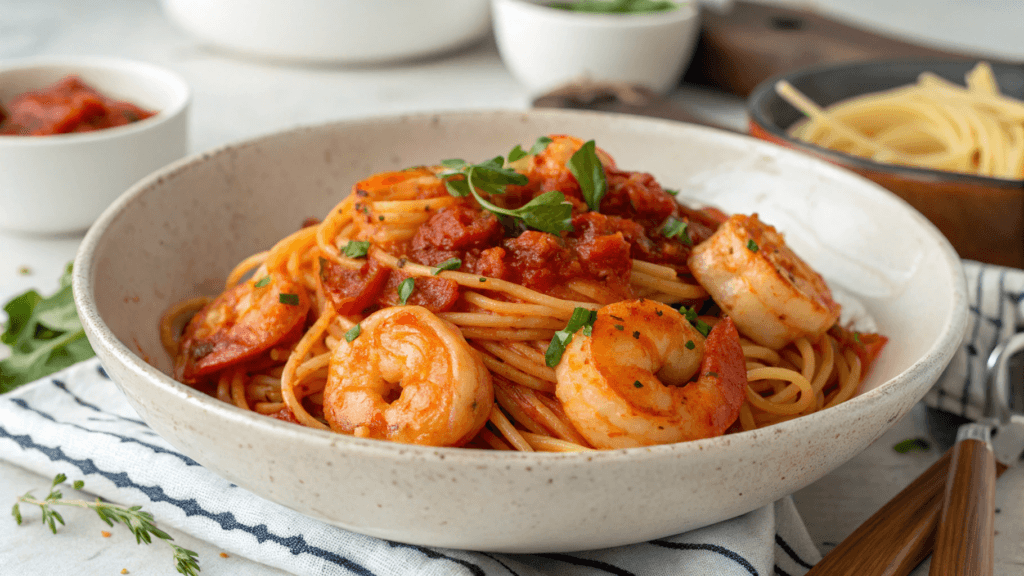
Ingredients:
- 8 ounces spaghetti or linguine
- 1 pound large shrimp, peeled and deveined
- 2 tablespoons olive oil
- 4 cloves garlic, minced
- 2 shallots, minced
- 1/4 cup water
- 2 tablespoons gochujang
- 2 tablespoons plant-based butter
- 1 tablespoon fresh lemon juice
- 1 tablespoon soy sauce or tamari
- Salt and freshly ground black pepper to taste
- Fresh parsley, chopped, for garnish
- Red pepper flakes, for garnish (optional)
Instructions:
- Cook the pasta: Bring a large pot of salted water to a boil. Add the pasta and cook until al dente according to package directions. Reserve about 1/2 cup of pasta water before draining.
- Sauté the aromatics: While the pasta is cooking, heat the olive oil in a large skillet or wok over medium heat. Add the garlic and shallots and cook until fragrant, about 1 minute.
- Cook the shrimp: Add the shrimp to the skillet and cook until pink and opaque, about 2-3 minutes per side. Remove the shrimp from the skillet and set aside.
- Make the gochujang sauce: In the same skillet, add the water and let it simmer for about 1 minute, scraping up any browned bits from the bottom. Add the gochujang, plant-based butter, lemon juice, and soy sauce. Whisk until the butter is melted and the sauce is smooth and slightly thickened.
- Combine: Add the cooked pasta and shrimp to the skillet with the gochujang sauce. Toss to coat, adding a little pasta water if needed to thin the sauce. Season with salt and pepper to taste.
- Garnish and serve: Garnish with fresh parsley and red pepper flakes (if desired). Serve immediately.
A. Tips and Variations
- Use jumbo shrimp for a more luxurious dish.
- Add cherry tomatoes or spinach for extra vegetables.
- Adjust the amount of gochujang to control the spiciness. For a milder dish, use less. Therefore, this gives you some variety.
B. Nutritional Information (per 100g)
| Nutrient | Amount |
| Calories | 165 kcal |
| Protein | 12 g |
| Total Fat | 5 g |
| Saturated Fat | 2 g |
| Cholesterol | 80 mg |
| Sodium | 280 mg |
| Total Carbohydrate | 18 g |
| Dietary Fiber | 2 g |
| Total Sugars | 2 g |
V. Recipe 2: Gochujang Chicken and Vegetable Stir-Fry Pasta
This is a quick and easy stir-fry pasta that’s loaded with colorful vegetables and savory chicken.
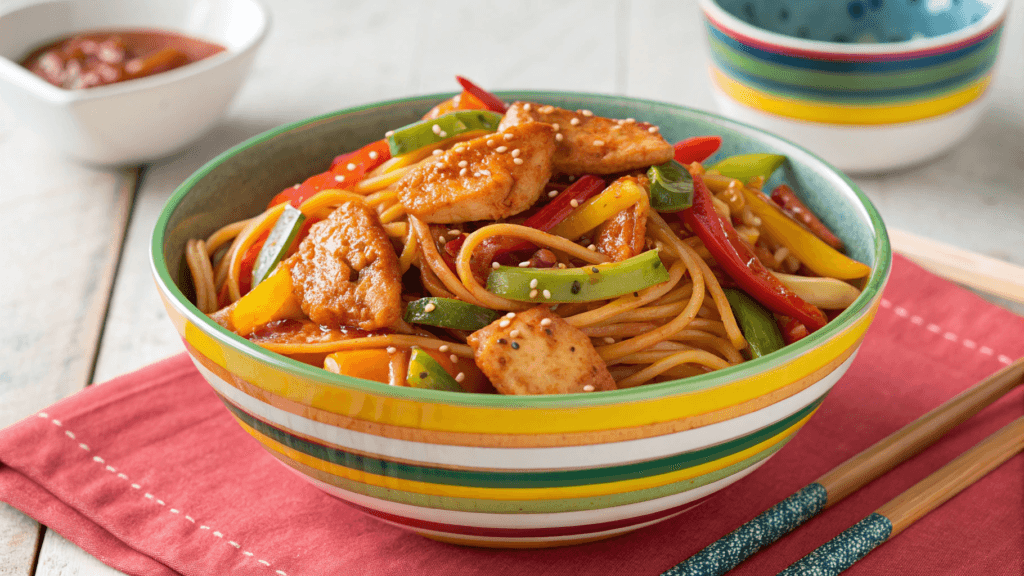
Ingredients:
- 8 ounces pasta (spaghetti, linguine, or fettuccine)
- 1 pound boneless, skinless chicken breasts, cut into 1-inch pieces
- 2 tablespoons gochujang
- 1 tablespoon soy sauce or tamari
- 1 teaspoon grated fresh ginger
- 2 cloves garlic, minced
- 1 red bell pepper, thinly sliced
- 1 cup broccoli florets
- 1/2 medium onion, sliced
- 2 tablespoons olive oil
- 1 tablespoon honey or maple syrup
- 1 tablespoon sesame oil
- 1 tablespoon rice vinegar
- Salt and freshly ground black pepper to taste
- Sesame seeds, for garnish
- Scallions, thinly sliced, for garnish
Instructions:
- Marinate the chicken: In a bowl, combine the chicken pieces with gochujang, soy sauce, ginger, and garlic. Marinate for at least 15 minutes (longer for deeper flavor).
- Cook the pasta: Bring a large pot of salted water to a boil. Add the pasta and cook until al dente according to package directions. Reserve about 1/2 cup of pasta water before draining.
- Stir-fry the vegetables: Heat the olive oil in a large skillet or wok over medium-high heat. Add the bell pepper, broccoli, and onion. Stir-fry for 3-4 minutes, or until the vegetables are tender-crisp. Remove the vegetables from the skillet and set aside.
- Cook the chicken: Add the marinated chicken to the skillet and stir-fry until cooked through and slightly browned, about 5-7 minutes.
- Make the gochujang sauce: In a small bowl, whisk together the honey or maple syrup, sesame oil, rice vinegar, and a tablespoon of water.
- Combine: Add the cooked pasta, stir-fried vegetables, and gochujang sauce to the skillet with the chicken. Toss to coat, adding a little pasta water if needed to thin the sauce. Season with salt and pepper to taste.
- Garnish and serve: Garnish with sesame seeds and scallions. Serve immediately.
A. Tips and Variations
- Use different vegetables like carrots, snap peas, or snow peas based on the season and your preferences.
- Substitute the chicken with plant-based proteins, such as tofu or tempeh, for a different protein.
- Adjust the honey/maple syrup to balance the gochujang spice. You can customize the flavors!
B. Nutritional Information (per 100g)
| Nutrient | Amount |
| Calories | 180 kcal |
| Protein | 15 g |
| Total Fat | 7 g |
| Saturated Fat | 2 g |
| Cholesterol | 60 mg |
| Sodium | 300 mg |
| Total Carbohydrate | 16 g |
| Dietary Fiber | 2 g |
| Total Sugars | 4 g |
VI. Recipe 3: Creamy Gochujang Pasta with Crispy Tofu
This plant-based dish offers a delightful contrast of textures: a creamy, flavorful sauce and crispy, golden tofu.
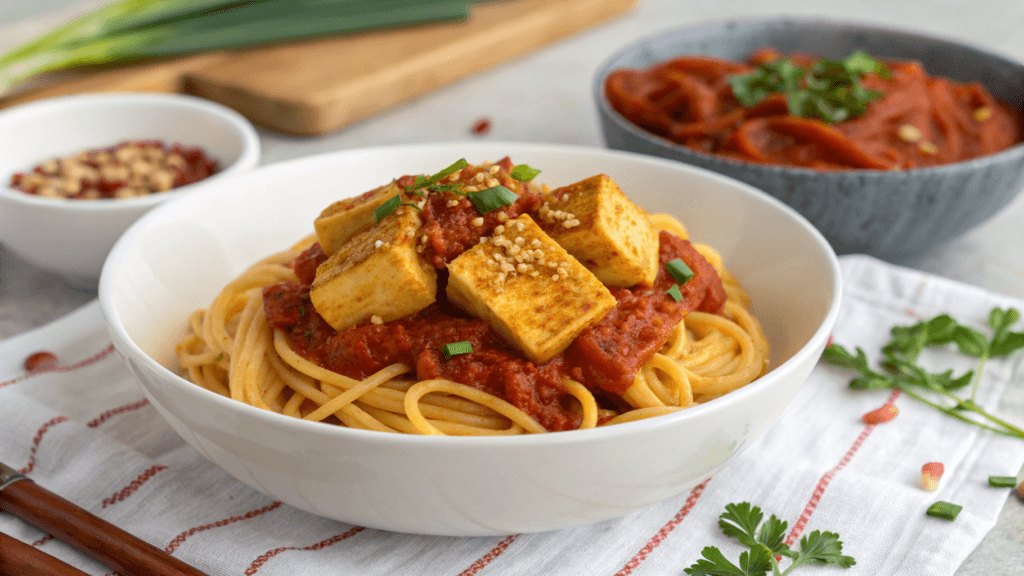
Ingredients:
- 8 ounces pasta (penne, rigatoni, or fusilli)
- 1 (14-ounce) block extra-firm tofu, pressed and cubed
- 2 tablespoons cornstarch or tapioca starch
- 2 tablespoons olive oil
- 4 cloves garlic, minced
- 1/2 medium onion, chopped
- 1 inch fresh ginger, minced
- 1 cup vegetable broth
- 1/2 cup plant-based heavy cream or coconut cream
- 3 tablespoons gochujang
- Salt and freshly ground black pepper to taste
- Sesame seeds, for garnish
- Scallions, thinly sliced, for garnish
- Chili flakes, for garnish (optional)
Instructions:
- Prepare the tofu: Press the tofu to remove excess water. Cut into 1/2-inch cubes. Toss the tofu cubes with cornstarch or tapioca starch until evenly coated.
- Crisp the tofu: Heat the olive oil in a large skillet over medium-high heat. Add the tofu and cook until golden brown and crispy on all sides, about 8-10 minutes. Remove the tofu from the skillet and set aside. Alternatively, air fry the tofu for 8-10 minutes.
- Cook the pasta: Bring a large pot of salted water to a boil. Add the pasta and cook until al dente according to package directions. Reserve about 1/2 cup of pasta water before draining.
- Make the creamy sauce: In the same skillet, sauté the garlic, onion, and ginger until softened, about 2 minutes. Add the vegetable broth, plant-based heavy cream (or coconut cream), and gochujang. Stir well to combine and bring to a simmer.
- Combine: Add the cooked pasta and crispy tofu to the skillet with the creamy gochujang sauce. Toss to coat, adding a little pasta water if needed to thin the sauce. Season with salt and pepper to taste.
- Garnish and serve: Garnish with sesame seeds, scallions, and chili flakes (if desired). Serve immediately.
A. Tips and Variations
- For extra crispy tofu, ensure it’s well-pressed and coated with a thin layer of starch.
- Adjust the amount of cream to control the sauce’s thickness.
- Add mushrooms or spinach to the sauce for added vegetables.
- Use nutritional yeast for extra cheesy flavor if making a vegan version. Therefore, you can change the dish in many ways.
B. Nutritional Information (per 100g)
| Nutrient | Amount |
| Calories | 200 kcal |
| Protein | 8 g |
| Total Fat | 12 g |
| Saturated Fat | 8 g |
| Cholesterol | 0 mg |
| Sodium | 250 mg |
| Total Carbohydrate | 18 g |
| Dietary Fiber | 3 g |
| Total Sugars | 3 g |
VII. Recipe 4: Gochujang Pasta with Spicy Mushrooms
This recipe focuses on the rich umami flavor of mushrooms, providing a satisfying and flavorful vegetarian dish.

Ingredients:
- 8 ounces pasta (spaghetti or fettuccine)
- 1 pound mixed mushrooms (such as cremini, shiitake, oyster), sliced
- 2 tablespoons olive oil
- 4 cloves garlic, minced
- 1 inch fresh ginger, minced
- 1/2 medium onion, chopped
- 1/4 cup soy sauce or tamari
- 2 tablespoons gochujang
- 2 tablespoons brown sugar
- 2 tablespoons rice vinegar
- 1 cup vegetable broth
- Salt and freshly ground black pepper to taste
- Scallions, thinly sliced, for garnish
- Sesame seeds, for garnish
- Chili flakes, for garnish (optional)
Instructions:
- Prepare the mushrooms: Sauté the mushrooms in a pan with a little olive oil until browned.
- Cook the pasta: Bring a large pot of salted water to a boil. Add the pasta and cook until al dente according to package directions. Reserve about 1/2 cup of pasta water before draining.
- Sauté the aromatics: In a large skillet, heat the olive oil over medium heat. Sauté the garlic, ginger, and onion until softened and fragrant, about 2 minutes.
- Make the sauce: In the same skillet, add the soy sauce, gochujang, brown sugar, rice vinegar, and vegetable broth. Stir well to combine and bring to a simmer.
- Combine: Add the cooked pasta and sauteed mushrooms to the skillet with the sauce. Toss to coat, adding a little pasta water if needed to thin the sauce. Season with salt and pepper to taste.
- Garnish and serve: Garnish with scallions, sesame seeds, and chili flakes (if desired). Serve immediately.
A. Tips and Variations
- If you like, add some spinach or kale for some greens.
- Use different types of mushrooms.
- Serve the dish with a side of kimchi for extra flavor.
B. Nutritional Information (per 100g)
| Nutrient | Amount |
| Calories | 190 kcal |
| Protein | 6 g |
| Total Fat | 8 g |
| Saturated Fat | 2 g |
| Cholesterol | 0 mg |
| Sodium | 350 mg |
| Total Carbohydrate | 25 g |
| Dietary Fiber | 3 g |
| Total Sugars | 7 g |
VIII. Recipe 5: Spicy Gochujang Carbonara with Plant-Based Protein
This recipe is a creative fusion, combining the rich flavor of carbonara with the spicy kick of gochujang and a plant-based protein.
Ingredients:
- 8 ounces spaghetti or bucatini
- 6 slices plant-based protein cut into 1/2-inch pieces
- 4 large egg yolks
- 1/2 cup grated Parmesan cheese
- 2 tablespoons gochujang
- Freshly ground black pepper, to taste
- Fresh parsley, chopped, for garnish
Instructions:
- Cook the plant-based protein: Cook the plant-based protein in a large skillet over medium heat until crispy. Remove the plant-based protein from the skillet and set aside, leaving the fat in the skillet.
- Cook the pasta: Bring a large pot of salted water to a boil. Add the pasta and cook until al dente according to package directions. Reserve about 1/2 cup of pasta water before draining.
- Prepare the egg mixture: In a bowl, whisk together the egg yolks and Parmesan cheese.
- Combine the gochujang and protein fat: Remove skillet from heat. Add gochujang to the protein fat in the skillet. Stir to combine.
- Combine the pasta and gochujang-fat mixture: Add the cooked pasta to the skillet with the protein fat and gochujang mixture. Toss to coat.
- Add the egg mixture: Quickly pour the egg yolk mixture over the hot pasta, tossing constantly with tongs to create a creamy sauce. The heat from the pasta will cook the eggs gently. If the mixture seems too thick, add a splash of the reserved pasta water.
- Add the plant-based protein and serve: Stir in the cooked plant-based protein. Season with freshly ground black pepper. Garnish with fresh parsley. Serve immediately.
A. Tips and Variations
- Work quickly when adding the egg mixture to prevent the eggs from curdling.
- Adjust the gochujang to alter the spice level.
- Substitute mushrooms for a vegetarian carbonara.
B. Nutritional Information (per 100g)
| Nutrient | Amount |
| Calories | 210 kcal |
| Protein | 12 g |
| Total Fat | 11 g |
| Saturated Fat | 5 g |
| Cholesterol | 150 mg |
| Sodium | 280 mg |
| Total Carbohydrate | 16 g |
| Dietary Fiber | 2 g |
| Total Sugars | 2 g |
IX. Serving and Pairing Suggestions
The final touches elevate your gochujang pasta from a simple meal to a memorable dining experience. Therefore, here are some tips and suggestions.
Consider the presentation. A simple garnish of fresh herbs like parsley or scallions can brighten the dish. A sprinkle of sesame seeds adds visual appeal and nutty flavor. Serving the pasta immediately ensures it’s at its optimal temperature and texture. Because of this, presentation makes all the difference.
As for side dishes, choose accompaniments that complement the spice and richness of the pasta. Kimchi, a Korean fermented vegetable dish, is a natural pairing, adding a contrasting sourness and more layers of spice. Edamame, with its subtle saltiness and refreshing flavor, can provide a pleasant contrast. Furthermore, a simple green salad with a light vinaigrette can balance the dish, providing some needed freshness.
Let’s talk about beverages. Choosing the right beverage can enhance the flavors of the pasta. For example, a light-bodied red wine can complement the flavors of gochujang well. In addition, a crisp white beverage can cut through the richness and add a refreshing element. Furthermore, a non-alcoholic drink, such as iced tea or sparkling water, can help cleanse the palate between bites. Because of this, selecting the right beverage is key.
X. Conclusion: Embrace the Gochujang Pasta Adventure
We’ve journeyed through five diverse and delicious gochujang pasta recipes, from the quick and easy shrimp scampi to the creamy tofu pasta. In addition, we explored vegetarian options, and even put a spicy twist on a classic carbonara. Each recipe offers a unique flavor profile, showcasing the versatility of gochujang. Because of this, it is a great and unique ingredient.
Now, it’s your turn to unleash your culinary creativity! Try these recipes at home, experiment with the ingredients, and adjust the spice levels to your liking. Don’t be afraid to adapt the recipes to your preferences. Therefore, the best part of cooking is making it your own.
We encourage you to share your gochujang pasta creations, provide feedback, and tag our website on social media. We love to see your culinary adventures! So, grab that gochujang, fire up the stove, and start your own gochujang pasta adventure!
XI. FAQ (People Also Ask)
- Gochujang pasta recipeThe recipes provided in this article offer several gochujang pasta options! Start with the spicy gochujang shrimp scampi pasta, gochujang chicken and vegetable stir-fry pasta, creamy gochujang pasta with crispy tofu, gochujang pasta with spicy mushrooms, or the spicy gochujang carbonara. Each recipe gives detailed instructions, and ingredient lists for a tasty meal!
- Creamy gochujang pastaThe creamy gochujang pasta with crispy tofu recipe is a perfect example of a creamy gochujang pasta. This vegan dish uses a creamy sauce made from gochujang, plant-based heavy cream or coconut cream, and vegetable broth. In addition, you can adjust the sauce’s creaminess to your liking!
- Gochujang butterGochujang butter is not directly discussed in this article. However, you can infuse butter with gochujang for a flavorful addition to bread, vegetables, or to use as a finishing touch in pasta sauces.
- Gochujang sauceGochujang sauce is essential to gochujang pasta. All the recipes provided in this article include a homemade sauce, using ingredients like gochujang, soy sauce, ginger, and garlic to make these flavorful and easy to make.
- Gochujang chickenThe gochujang chicken and vegetable stir-fry pasta is an excellent example. The chicken is marinated in a gochujang-based mixture, providing a flavorful and savory base for the stir-fry pasta dish.
- Carbonara gochujangThe spicy gochujang carbonara recipe is provided in this article. This innovative recipe combines a classic carbonara with the unique flavors of gochujang and a plant-based protein.
- Ssamjang pastaSsamjang pasta isn’t discussed in this article. However, ssamjang is another Korean sauce that can be used in pasta.
- Tofu pastaThe creamy gochujang pasta with crispy tofu recipe shows you how to include tofu in a pasta dish. This dish provides a vegetarian option with a flavorful sauce and crispy tofu.
Cooking is an act of love and creativity! 🌟 What do you think of this recipe? I’d love to hear your thoughts and any tips or tweaks you’d suggest to make it even better. Let’s inspire each other in the kitchen!
There are no reviews yet. Be the first one to write one.


